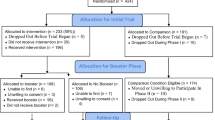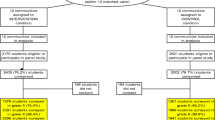Abstract
We describe a university-community collaborative effort to tailor and deliver a prevention program for families of preschoolers living in low-income, urban communities. ParentCorps, which builds on efficacious interventions with parents and young children, aims to promote child social competence and prevent conduct problems by strengthening parenting skills, enhancing support for parents, and empowering parents to access resources in their communities. Active community engagement and collaboration were viewed as critical to the development of the program and its feasibility testing. We present an overview of community involvement in the development of ParentCorps and approaches taken to involve community members during a feasibility study. Areas of success and lessons learned are discussed.
Similar content being viewed by others
References
Attar, B. K., Guerra, N. G., & Tolan, P. H. (1994). Neighborhood disadvantage, stressful life events, and adjustment in urban elementary-school children. Journal of Clinical Child Psychology, 23, 391–400.
Berman, J. S., & Norton, N. C. (1985). Does professional training make a therapist more effective? Psychological Bulletin, 98, 401–407.
Boyd-Franklin, N. (1989). Black families in therapy: A multisystems approach. New York: The Guilford Press.
Brestan, E. V., & Eyberg, S. M. (1998). Effective psychosocial treatments of conduct-disordered children and adolescents: 29 years, 82 studies, and 5,272 kids. Journal of Clinical Child Psychology, 27, 180–189.
Bright, J. I., Baker, K. D., & Neimeyer, R. A. (1999). Professional and paraprofessional group treatments for depression: A comparison of cognitive-behavioral and mutual support interventions. Journal of Consulting and Clinical Psychology, 67, 491–501.
Brody, G. H., Ge, X., Conger, R., Gibbons, F. X., Murry, V. M., Gerrand, M., & Simons, R. L. (2001). The influence of neighborhood disadvantage, collective socialization, and parenting on African American children’s affiliation with deviant peers. Child Development, 72, 1231–1246.
Brooks-Gunn, J., & Duncan, G. J. (1997). The effects of poverty on children. Future of Children, 7, 55–71.
Butterfoss, F. D., Goodman, R. M., & Wandersman, A. (1996). Community coalitions for prevention and health promotion: Factors predicting satisfaction, participation, and planning. Health Education Quarterly, 23, 65–79.
Calzada, E. J., Caldwell, M. B., Miller Brotman, L., Brown, E. J., Wallace, S. A., McQuaid, J. H., Rojas-Flores, L., & O’Neal, C. R. (2004). Training community members to serve as paraprofessionals in an evidence–based, community prevention program. Journal of Child and Family Studies, 14, 387–402.
Chavis, D. M. (2001). The paradoxes and promise of community coalitions. American Journal of Community Psychology, 29, 309–329.
Christensen, A., & Jacobson, N. S. (1994). Who (or what) can do psychotherapy: The status and challenge of nonprofessional therapies. Psychological Science, 5, 8–14.
Coard, S. I., Wallace, S. A., Stevenson, H., & Miller, L. S. (2003). Towards culturally relevant preventive interventions: The consideration of racial socialization in parent training with African American families. In Press.
Conduct Problems Prevention Research Group. (1992). A developmental and clinical model for the prevention of conduct disorder: The FAST Track Program. Development and Psychopathology, 4, 509–527.
Dodge, K. A., Pettit, G. S., & Bates, J. E. (1994). Socialization mediators of the relation between socioeconomic status and child conduct problems. Child Development, 65, 649–665.
Dumas, J. E., Prinz, R. J., Smith, E. P., & Laughlin, J. (1999). The EARLY ALLIANCE Prevention Trial: An integrated set of interventions to promote competence and reduce risk for conduct disorder, substance abuse, and school failure. Clinical Child and Family Psychology Review, 2, 37–53.
Duncan, G. J., Brooks-Gunn, J., & Klebanov, P. K. (1994). Economic deprivation and early childhood development. Child Development, 65, 296–318.
Fawcett, S. B., Paine, A. L., Francisco, V. T., & Vliet, M. (1993). Promoting health through community development. In L. A. Jason (Ed.), Promoting health and mental health in children, youth, and families. Springer series on behavior therapy and behavioral medicine (Vol. 27, pp. 233–255). New York: Springer Publishing Co, Inc.
Fawcett, S. B., Paine-Andrews, A., Francisco, V. T., Schultz, J. A., Richter, K. P., Lewis, R. K., Williams, E. L., Harris, K. J., Berkley, J. Y., Fisher, J. L., & Lopez, C. M. (1995). Using empowerment theory in collaborative partnerships for community health and development. American Journal of Community Psychology, 23, 677–697.
Fisher, C. B., & Wallace, S. A. (2000). Through the community looking glass: reevaluating the ethical and policy implications of research on adolescent risk and sociopathology. Ethics and Behavior, 10, 99–118.
Forehand, R. L., & McMahon, R. J. (1981). Helping the noncompliant child: A clinician’s guide to parent training. New York: Guilford.
Foster-Fishman, P. G., Salem, D. A., Allen, N. A., & Fahrbach, K. (2001). Facilitating interorganizational collaboration: The contributions of interorganizational alliances. American Journal of Community Psychology, 29, 875–905.
Hatch, J., Moss, N., Saran, A., Presley-Cantrell, L., & Mallory, C. (1993). Community research: Partnership in Black communities. American Journal of Preventive Medicine, 9(Suppl), 27–31.
Hattie, J. A., Sharpley, C. F., & Rogers, H. J. (1984). Comparative effectiveness of professional and paraprofessional helpers. Psychological Bulletin, 95, 534–541.
Hawkins, J. D., & Catalano, R. F., Jr. (1992). Communities that care: Action for drug abuse prevention: (1992). City, State: Publisher ???
Hiatt, S. W., Sampson, D., & Baird, D. (1997). Paraprofessional home visitation: Conceptual and pragmatic considerations. Journal of Community Psychology, 25, 77–93.
Himmelman, A. T. (2001). On coalitions and the transformation of power relations: Collaborative betterment and collaborative empowerment. American Journal of Community Psychology, 29, 277–284.
Israel, B. A., Schultz, A. J., Parker, E. A., & Becker, A. B. (1998). Review of community-based research: Assessing partnership approaches to improve public health. Annual Review of Public Health, 19, 173–202.
Jensen, P. S., Hoagwood, K., & Trickett, E. J. (1999). Ivory towers or earthen trenches? Community collaborations to foster real-world research. Applied Developmental Science, 3, 206–212.
Jordan, L. C., Bogat, G. A., & Smith, G. (2001). Collaborating for social change: the black psychologist and the black community. American Journal of Community Psychology, 29, 599–620.
Kazdin, A. E. (1993). Treatment of conduct disorder: Progress and directions in psychotherapy research. Development and Psychopathology, 5, 277–310.
Kellam, S. G., Rebok, G. W., Ialongo, N., & Mayer, L. S. (1994). The course and malleability of aggressive behavior from early first grade into middle school: Results of a developmental epidemiology-based preventive trial. Journal of Child Psychology and Psychiatry and Allied Disciplines, 35, 259–281.
Kelly, J. G., Dassoff, N., Levin, I., Schreckengost, J., Stelzner, S. P., & Altman, B. E. (1988). A guide to conducting prevention research in the community: First steps. Prevention in Human Services, 6, 1–174.
Kotkin, R. (1998). The Irvine Paraprofessional Program: Promising practice for serving students with ADHD. Journal of Learning Disabilities, 31, 556–564.
Lantz, P. M., Viruell-Fuentes, E., Israel, B. A., Sofley, D., & Guzman, R. (2001). Can communities and academia work together on public health research? Evaluation results from a community-based participatory research partnership in Detroit. Journal of Urban Health, 78, 495–507.
Lee, F. R. (2000). For Harlem’s Children, a Catcher in the Rye. The New York Times, January 9, 2000, Sunday Late Edition.
Leventhal, T., & Brooks-Gunn, J. (2000). The neighborhoods they live in: the effects of neighborhood residence on child and adolescent outcomes. Psychological Bulletin, 126, 309–337.
Lynn, C. J., McKay, M. M., Hibbert, R., Carrera, S., Lawrence, R., Miranda, A., Jarvis, A., Gamble, D., & Palacios, J. (2001). Developing collaborations with parents and schools to promote urban-child mental health. Emotional and Behavioral Disorders in Youth, 45, 31–32.
McLoyd, V. C. (1990). The impact of economic hardship on Black families and children: Psychological distress, parenting, and socioemotional development. Child Development, 61, 311–346.
McLoyd, V. C. (1998). Socioeconomic disadvantage and child development. American Psychologist, 53, 185–204.
McMahon, R. J., & Forehand, R. (2003). Helping the noncompliant child (2nd ed.). New York: Guilford Press.
Miller Brotman, L., Klein, R. G., Kamboukos, D., Brown, E. J., Coard, S. I., & Sosinsky, L. S. (2003). Preventive intervention for urban, low-income preschoolers at familial risk for conduct problems: A randomized pilot study. Journal of Clinical Child and Adolescent Psychology, 32, 246–257.
Miller, L. S. (2001). A day in the life of a preschooler. [60 minute, 9-part video series for parents of preschoolers]. New York, NY: Media Works, Inc.
Miller, L. S., Wasserman, G. A., Neugebauer, R., Gorman-Smith, D., & Kamboukos, D. (1999). Witnessed community violence and antisocial behavior in high-risk, urban boys. Journal of Clinical Child Psychology, 28, 2–11.
Musick, J., & Stott, F. (2000). Paraprofessionals revisited and reconsidered. In S. J. Meisels (Ed.), Handbook of early childhood intervention (2nd ed., pp. 439–453). New York: Cambridge University Press.
Musser-Granski, J., & Carrillo, D. F. (1997). The use of bilingual, bicultural paraprofessionals in mental health services: Issues for hiring, training, and supervision. Community Mental Health Journal, 33, 51–60.
Nelson, G., Prilleltensky, I., & MacGillivary, H. (2001). Building value-based partnerships: Toward solidarity with oppressed groups. American Journal of Community Psychology, 29, 649–677.
Patterson, G. R., Dishion, T. J., & Bank, L. (1984). Family interaction: A process model of deviancy training. Aggressive Behavior, 10, 253–267.
Reid, J. B., Eddy, J. M., Fetrow, R. A., & Stoolmiller, M. (1999). Description and immediate impacts of a preventive intervention for conduct problems. American Journal of Community Psychology, 27, 483–517.
Rheedlen. (1999). Harlem Children’s Zone Survey Results. New York: Author.
Roosa, M. W., Dumka, L. E., Gonzales, N. A., & Knight, G. P. (2002). Cultural/ethnic issues and the prevention scientist in the 21st century. Prevention and Treatment, 5, posted January 15, 2002.
Schoenwald, S. K., & Hoagwood, K. (2001). Effectiveness, transportability, and dissemination of interventions: What matters when. Psychiatric Services, 52, 1190–1197.
Shaw, D. S., Owens, E. B., Giovannelli, J., & Winslow, E. B. (2001). Infant and toddler pathways leading to early externalizing disorders. Journal of the American Academy of Child and Adolescent Psychiatry, 40, 36–43.
Webster-Stratton, C. (1987). Parents and children: A 10 program videotape parent training series with manuals. Eugene, OR: Castalia Press.
Webster-Stratton, C. (1990). Leader’s guide for teachers and therapists: The teachers and children’s videotape series, Dina Dinosaur’s Social Skills and Problem-Solving Curriculum.
Webster-Stratton, C., Reid, M. J., & Hammond, M. (2001). Preventing conduct problems, promoting social competence: A parent and teacher training partnership in Head Start. Journal of Clinical Child Psychology, 30, 283–302.
Webster-Stratton, C., & Taylor, T. (2001). Nipping early risk factors in the bud: Preventing substance abuse, delinquency, and violence in adolescence through interventions targeted at young children (0 to 8 Years). Prevention Science, 2, 165–192.
Weisz, J. R., Weiss, B., Han, S. S., & Granger, D. A. (1995). Effects of psychotherapy with children and adolescents revisited: A meta-analysis of treatment outcome studies. Psychological Bulletin, 117, 450–468.
Whyte, W. F. (1991). Participatory action research. Thousand Oaks, CA: Sage Publications, Inc.
Wolff, T. (2001a). The future of community coalition building. American Journal of Community Psychology, 29, 263–268.
Wolff, T. (2001b). A practitioner’s guide to successful coalitions. American Journal of Community Psychology, 29, 173–191.
Zimmerman, M. A. (2000). Empowerment theory: Psychological, organizational, and community levels of analysis. In E. Seidman (Ed.), Handbook of community psychology (pp. 43–63). Dordrecht, Netherlands: Kluwer Academic Publishers.
Author information
Authors and Affiliations
Corresponding author
Rights and permissions
About this article
Cite this article
Caldwell, M.B., Brotman, L.M., Coard, S.I. et al. Community Involvement in Adapting and Testing a Prevention Program for Preschoolers Living in Urban Communities: ParentCorps. J Child Fam Stud 14, 373–386 (2005). https://doi.org/10.1007/s10826-005-6850-6
Issue Date:
DOI: https://doi.org/10.1007/s10826-005-6850-6




